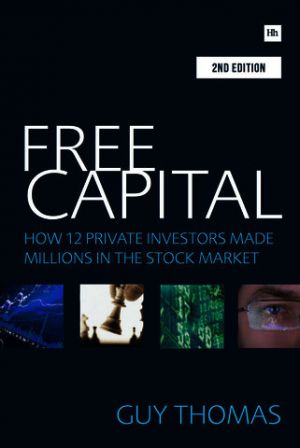
Wouldn't life be better if you were free of the daily grind ? the conventional job and boss ? and instead succeeded or failed purely on the merits of your own investment choices?
Personal investing can radically change your life. It is probably not reasonable to plan on the basis that it will, but it can; and for each of the twelve investors profiled in Guy Thomas? new book, Free Capital, it has.
Based on a series of interviews with twelve highly successful private investors, Free Capital outlines these investors? strategies, wisdom and lifestyles to show how each has come to accumulate £1m or more mainly from stock market investment.
Rather than building their wealth through their salaries, or from building and selling businesses, these twelve individuals have made their money entirely from the quality of their own decisions in the stock market ? most starting out with just modest savings.
Guy Thomas? book is not a ?how-to? book or a manifesto. Instead it is a collection of personal stories, each one letting you into the inner sanctum a top private investor in the UK. The habits and strategies they share can also be used to improve your own investment or trading performance.
The first of these personal stories is detailed in ?Luke: The Big Picture?. Luke is a top-down investor, whose approach is to start by looking at the direction of the bigger investment landscape as he sees it, and then to work his way down to individual companies. He trades sparingly, focusing on the quality of decisions he makes, rather than the quantity, thereby reducing his commission costs and also the indirect costs of acting on weak information. He argues that ?one of the big mistakes in investing is to think you?ve always got to be doing something.?
The author then recounts Luke?s education and life, and what brought him to leave his job and begin investing. Following a career in investment banking, Luke began an advisory job, but shortly came to realise that the money he was earning in his private share portfolio far exceeded his salary, and perhaps his time would be better spent investing. He left full-time employment in 2002 and has been a private investor ever since.
Thomas looks then in more detail at the approach that Luke takes towards his investing. For example, he invests in very few stocks, no more than six, and then holds on to them whilst continually doing research. This means that he is indifferent to short-term price movements as he feels that it is ?better to have a few good long-term friends, rather than change your friends every week for short-term advantage.? Although not a how-to guide, the insights into a successful investors approach are useful and informative, especially if readers can apply this to their own circumstances. He illustrates his points with examples of charts from particular trades,
A similar pattern follows with the other eleven individuals, and at the end of each chapter, Thomas offers a useful conclusion plus details of any books or websites mentioned in the chapter.
The conclusion of the book itself looks back over the twelve individuals, and comments on their similarities and differences. He points out ?It is worth noting the fact that there are substantial differences between the investors...there is no single blueprint for stock market success.? Instead, there are many paths to success and this means that each individual can find their own way.
Free Capital offers practical ideas and inspiration, with revealing detail and minimal jargon, making it an indispensable read for novice and experienced investors alike.